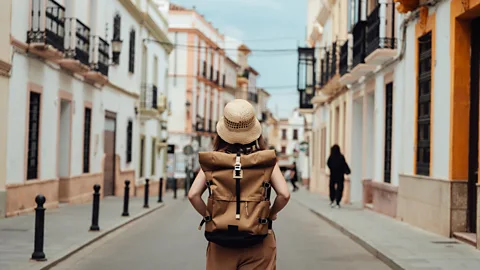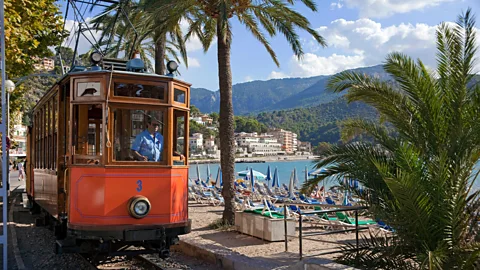A better way to 'raw-dog' travel
 Getty Images
Getty ImagesThe viral trend of enduring long flights with no phones, screens or distractions recently captured the world's attention. But what if we remain unplugged once we step off a plane?
It's all about the power of the mind – or so they say. The viral trend of "raw-dogging" long flights, where passengers stare straight ahead without any in-flight entertainment, books, music or screens, and refrain from eating, drinking or sleeping for the entire journey, captured the world's attention this summer. Manchester City forward Erling Haaland posted a video of himself on a seven-hour flight, boasting "no phone, no sleep, no water, no food". He wasn't the only celebrity to get in on the act, with Australian music producer Torren Foot and actor and musician Jared Leto also sharing their respective 15- and 17- hour raw-dogging experiences.
While it may be easy to dismiss raw-dogging (and its rather obscene name) as foolish or even nihilistic, it undoubtedly says something about our digital dependency: we're so reliant on external stimuli that going without distractions for several hours is now considered a "challenge". Yet, studies have shown that focusing on the present and being mindful can have a positive impact on health and wellbeing, including reducing anxiety, depression and blood pressure while improving sleep. Excessive smartphone use, meanwhile, can be detrimental to our physical and mental well-being, and it impacts everything from our sleep routines to our musculoskeletal health. That should be your cue to power off and sit up straighter.
As with every viral challenge, there's a darker side to raw-dogging. Medical professionals warn that in extreme cases, where participants avoid drinking water, moving or even using the bathroom on long flights, the viral trend is so dangerous it could even kill you.
While avoiding external stimuli is counterintuitive to travel, I still wondered whether there was something deeper or even mindful about the digital detox part of the raw-dogging trend that I could apply to my trip once I stepped off a plane.
 Getty Images
Getty ImagesIf one of the great purposes of travel is seeking out new experiences and escaping our regular routines, why are we so tethered to the same devices and screens we rely on back home? I thought it would feel refreshing to turn off my phone for the entirety of a trip. Perhaps this mental cleanse, free from apps and notifications, would allow me to connect more deeply with a new setting and rediscover the way people have travelled throughout history.
I decided to apply this part of raw-dogging a flight to raw-dogging a destination: no phone, no social media, no distractions; just a traveller absorbing a new environment while trying to stay as present as possible in the moment.
THOUGHTFUL TRAVEL
Want to travel better? Thoughtful Travel is a series on the ways people behave while away, from ethics to etiquette and more.
The Spanish city of Palma, Mallorca, may not seem like an obvious place for a mindful retreat. Its reputation as a sun-soaked playground, where many tourists do little more than tan, party and sip cocktails is one of many reasons why residents have recently pushed back against overtourism. As the city has increasingly become flooded by partiers and selfie-takers, locals are now fighting to reclaim it. By keeping my phone off, my aim was to meet these people, listen to their recommendations and explore a more soulful side of the city.
Upon arriving, I decided against jumping on a bus or hailing a taxi, embracing the city's surprisingly walkable nature by travelling from the airport to my lodging by foot. The directions were easy to remember: get to the beach, turn left and follow the coastline until I reached my street. Without music or a podcast, I listened to the sounds of distant waves hitting the beach and the way locals wove in and out of Spanish and Mallorca's other official language, Mallorquín, a variation of Catalan. This soundtrack accompanied my first glimpse of Palma: its distinctive honey-hued stone buildings, its dramatic Gothic and Baroque buildings and – yes – the many foreign visitors crowding the beaches.
 Getty Images
Getty ImagesI'm so used to consulting that live dot on my phone's Google Maps app, that without it, I began to worry that I'd gone the wrong way. I asked a group of elderly women sitting outside a cafe if I was heading in the right direction, showing them the address scribbled on the inside of my notebook cover. They nodded, and with a few gestures and finger-pointing, they steered me towards my destination.
After a brief swim in the sea, I took a bus to Palma's historic centre where I met a 23-year-old Turkish man named Erten, who had been studying in Mallorca. I asked him for his recommendations, and soon, Mallorcans sitting nearby chimed in with their own suggestions. One lady pointed out of the window at the pop-up markets lining the streets. Shaking her head dismissively, she remarked, "These markets are for tourists. If you want a real market, go to Santa Catalina. It's much better."
Erten was a pastry aficionado, and he insisted no visit to Palma was complete without eating an ensaïmada (a traditional coil-shaped Mallorcan pastry traditionally stuffed with lard and enjoyed with coffee). As a vegan, I didn't hold out much hope, but as I'd soon learn, each bakery seems to offer its own take on the delicacy.
After getting off the bus, I came across a family-run bakery called Fornet de la Soca that has been specialising in reviving once-forgotten Mallorcan pastries and breads for the past 14 years. The owners use rediscovered varieties of Mallorcan flour (such as vestit and xeixa) to make their canyalons (cream-filled pastries), robiols (lamb- or fruit-stuffed turnovers) and ensaïmadas.
 Getty Images
Getty ImagesThe bakery's sweeter ensaïmadas were filled with fruits from Sóller, an idyllic nearby town that customers at the bakery insisted I should visit. An elderly lady (carrying a bag full of ensaïmadas for her grandchildren) told me Sóller is known for its agricultural heritage – especially its prized citrus fruits. As if noticing my interest had been piqued, an otherwise quiet woman chimed in excitedly, "And you take a wooden train to get there!"
That settled it, I decided. I'd board a vintage train the following afternoon.
More like this:
• The town that banned influencers
• Four countries that are actively welcoming travellers
• How a viral ad campaign is teaching us to 'life-see', not sightsee
Soundtracked by the gentle rattle of old wooden carriages, the train ride to Sóller took me back in time. As we began to leave Palma's cobbled streets behind, the bars packed with German and British tourists slowly disappeared, and were replaced by lush valleys and rugged peaks. On our slow ascent up the Unesco-inscribed Serra de Tramuntana mountain range, I marvelled at Mallorca's "backbone", and felt grateful to the locals who pushed me out of the city centre.
Having already spent more than an hour inside Palma's stunning La Seu Cathedral that morning, I was happy to admire Sóller's Gothic Sant Bartomeu Church from its nearby square. As I sat with a coffee, I started talking to an older Mallorcan man who had lived in Sóller for most of his life. He said you could smell the strong aroma of oranges on the outskirts of the town, inhaling deeply for full effect. When he found out I was Irish, he became more animated and started clicking his fingers until the words came to him. "Star Trek!" he finally exclaimed. It turned out that Irish actor Colm Meaney (or "Miles O'Brien" to Trekkies) had lived nearby.
 Alamy
AlamyBack in Palma, I continued to wander and seek out local stories. Near the bay in the city's historic fishing neighbourhood of El Jonquet, windmills decorated the skyline. A woman organising boat tours at the marina told me they date back to the 14th Century, explaining that these landmarks offer glimpses into Mallorca's rural past, when they were used to grind grain and pump water. In total, there are around 3,000 preserved on the island. "They are symbols of our history," she added, with more than a hint of pride.
During my stay, I made a point to ask as many Mallorcans as I could how they wished tourists would behave when visiting their island. Aside from keeping their shirts on when stumbling through Palma's Old Town, one of the most common answers was for visitors to take more of an interest in local culture.
"Every place in the Old Town of Palma has its own history. I really like it when people ask us about ours and why we chose that area," said Andrea Santioana, who opened vegan restaurant Ca n’Ela with her mother four years ago. "The Mallorcan stone has a stunning, authentic beauty, and the rich history of each street is enchanting."
While having a phone meant that I didn't feel compelled to tick off a list of sights and could instead absorb Palma more on my own terms, it wasn't without its challenges. The idea of stumbling across a vegan spot is appealing until hunger kicks in, at which point you're ready to settle for a portion of generic Spanish patatas bravas (potatoes in tomato sauce). It's a good thing I didn't, though, as I savoured every bite of a seitan dish topped with lemon cream at Ca n’Ela.
 Getty Images
Getty ImagesIn the end, my trip to Palma and Sóller reaffirmed the value of staying present in our increasingly distracted world. I often lean on online recommendations when I travel, but by casting my phone aside and relying only on local recommendations, I rediscovered the joy of spontaneity and connection at the core of travel. While our screens can make for convenient travel companions, they can also get in the way of simple joys like following your curiosity down a street, approaching a stranger and allowing yourself to get lost while wandering through a new neighbourhood.
On the plane ride home, I felt the urge to dig into my bag and power my phone on. Instead, I took out my notepad and spent the flight documenting where my conversations led me. These memories were far more meaningful than anything I could scroll through later.
--
If you liked this story, sign up for The Essential List newsletter – a handpicked selection of features, videos and can't-miss news, delivered to your inbox twice a week.
